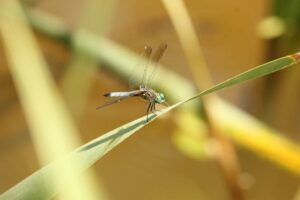By volunteer
 I Dwell underwater for most of my life
I Dwell underwater for most of my life
Ravenously eating nearly all thats in sight.
Aquatic invertebrates are my favorite dish, but if
Given a chance I might eat a small fish. I
Outgrow my skin, molt many times and…
Next crawl out of the water to try life on dry land.
Flight is my specialty, each wing moves on its own.
Look! My two eyes are many so I’m always in the zone!
Yes, my time on land is short, and that may leave you in a rut, but it’ll give you a chuckle that I once breathed through my butt!
I Dwell underwater for most of my life
When someone mentions dragonflies, the imagination almost always drifts to the winged needle-like creatures seen frequenting ponds, rivers, and meadows. However, it may surprise you to know that dragonflies actually begin their lives in the water when a female deposits her eggs either in or near the water. One researcher measured the aquatic larval stage of a Black-tipped Darner to be between 492 and 499 days. Other species may spend much longer – some up to six years – in this phase.
Ravenously eating nearly all thats in sight.
Aquatic invertebrates are my favorite dish, but if
Given a chance I might eat a small fish
During the Black-tipped Darner’s journey from larvae to adult, the following was on the menu: 1095 mosquito larvae, 180 mosquito pupae, 87 mayfly larvae, 20 damsel fly larvae, 8 miscellaneous dragonfly larvae (yes, they are cannibals!) 1 diving beetle, and 2 water scavenger beetles, 2 back swimmers, 4 dixid stonefly larvae, 1 perlid stonefly larvae, 2 midge pupae, and 2 frog tadpoles (minus the tails). In short, the main question a dragonfly larvae may ask in determining what to eat is ‘can I overpower it’? If so, whatever it is, it becomes dinner!
I Outgrow my skin, molt many times and…
A dragonfly, like butterflies and frogs, experiences metamorphosis, or ‘change of form’ as it transitions through various stages of development leading up to adulthood. Along the way, the dragonfly will molt, casting off its exoskeleton to allow further growth. Though the number of molts varies, depending on species and conditions, it is typically between 10-15 times, with the average being 12.
Next crawl out of the water to try life on dry land.
Having proven its prowess in the water, the dragonfly must leave its watery lair for its final molt and to complete its life cycle. This is an extremely vulnerable period in a dragonfly’s life, as they must avoid predators such as hungry reptiles, amphibians and even fire ants as they search for a safe place to perform this final transition. This safe place is usually a reed, rock, or sometimes a wall. Over the next several hours, the legs stiffen and lock into place. The teneral dragonfly emerges from its shell, pumping its body and wings full of air and hemolymph and allows its body and wings to harden preparing for the aviator phase of life.
Flight is my specialty, each wing moves on its own.
Unlike most flying insects, a dragonfly has two pairs of wings and direct musculature allowing muscles to pull directly on the wings themselves rather than on the body wall. This design enables each wing to move independently. Also unique is the fact that the each pair of wings can beat out of phase – that is while one pair goes up, the other can go down. The result is a dragonfly’s ability to master the sky – hovering, gliding, moving up and down, and back and forth with great efficiency and speed (up to 38 mph in some instances!) Dragonflies can hunt, eat, and even mate in flight!
Look! My two eyes are many so I’m always in the zone!
In addition to their masterful flight abilities, the dragonfly also has amazing sight abilities. While it may appear that there are two eyes looking at you, the eyes are compound, made up of thousands of simple eyes, or ‘ommatidia’. These eyes work together as a single unit, providing the dragonfly with a near 360 degree field of vision. It is no wonder that 80% its their brain is devoted to processing vision. Disclaimer: although the field of vision is near 360 degrees, it is not in great detail, thus, you may see a dragonfly caught in a spiderweb.
Yes, my time on land is short, and that may leave you in a rut,
Compared to its aquatic larvae stage which may last 1-6 years depending on the species, the dragonfly’s time as an aerial being may be as short as one month. The primary focus in this stage is to eat whatever it can overpower (for which we humans are grateful) and to mate in order to start the cycle again. For male dragonflies, this time includes fiercely patrolling his territory, running off other males that are competition for mates. For females, finding the best place to deposit her eggs enhances her chance for survival. The dragonfly’s sad end is usually in the mouth of one of its many predators – birds, spiders, praying mantids, reptiles, or other dragonflies; or because of exhaustion or the onset of cold weather.
…but it’ll give you a chuckle that I once breathed through my butt!
Bonus fun fact: During its larval stage, the dragonfly breathes by filling its rectum with oxygenated water allowing the feathery gills to pull the oxygen throughout its body. This same mechanism is used as jet-propulsion, getting the nymph where it needs to be…fast! The dragonfly’s body plan has barely changed other than in size over the last 300 million years. Perfected over time, it is no surprise that they are known as the most successful of life forms!

